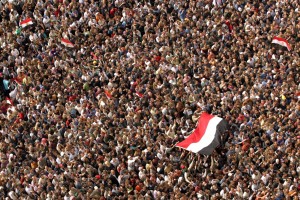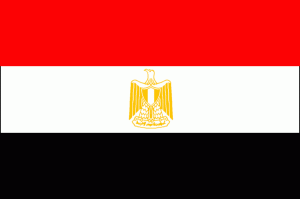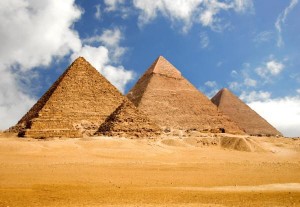 Egypt Population 2014
Egypt Population 2014
Based on the total number of births, total number of deaths, net migration rate, and the population of 2013, the current population of the Arab Republic of Egypt is estimated to be about 82,933,091. The Egyptian population makes up about 1.15% of the world’s total population. It ranks 15th in the population rankings, behind Vietnam, but ahead of Germany. Egypt is the third-most populous country in Africa and the most populated country in the area considered the Middle East. At the end of 2013, the Egyptian population was recorded to be an estimated 82,056,378. Therefore, since the beginning of 2014, there has been an approximate growth of 876,713 people or an approximate growth rate of 1.07%. Based on the total population and the total land area, the population density of the Egypt is estimated to be about 82.73 people per square kilometer or 214.27 people per square mile.
Demographics of Egypt
The major ethnic group in the Arabic Republic of Egypt is native Egyptians and also Arabs. In certain parts of the country, there is a community of those that identify as Nubian and those that identify as Berber. However, the mix of the Arab and Egyptian cultures characterizes the current population and culture. The official language of the country is Modern Standard Arabic. 68% of the population speaks Egyptian Arabic, while 29% of the population speaks Sa’idi Arabic.
Geography of Egypt
The land area of Egypt totals 1,001,450 square kilometers or 386,660 square miles, making it the 30th largest country in the world. Because Egypt’s climate is so arid, the majority of people live in the regions surrounding the Nile Valley and the Delta. So, 99% of the Egyptian population lives on 5.5% of the total land area and 98% of the population lives on 3% of the total land. Egypt’s borders include Libya to the west, Sudan to the south, the Gaza Strip to the east, and Israel to the east. The Isthmus of Suez connects the African continent to the Asian continent. The Suez Canal connects the Mediterranean Sea with the Indian Ocean through the Red Sea. The major geographic features of the country are the deserts and oases. Parts of the Sahara and Libyan Deserts are located within Egypt. Lastly, as a result of the strong winds in the deserts, many sand dunes exist, reaching about 100 feet in height.
Government of Egypt
The Egyptian form of government is based on republicanism and has a semi-presidential system. A referendum in 2011 limited the president to two four-year terms. Currently, the Supreme Justice is acting as President after the Egyptian Constitution was suspended in July of 2013 and former-President Morsi was forced to leave. The Egyptian Parliament was formerly a bicameral legislature made up of the People’s Assembly and the Consultative Council. However, after the drafting of the 2014 Egyptian Constitution, the Egyptian government decided to abolish the Consultative Council. The People’s Assembly, made up of 454 deputies, 444 of which are elected and up to 10 are appointed by the President. The Assembly has the power to impeach the president.
Human Rights Issues in Egypt
There have been many issues throughout the last century that have caused many human rights organizations to view the situation in Egypt. The PewResearchCenter conducted a poll in 2010, which indicated that 84% of Egyptian Muslims, which is also 75% of the Egyptian population, felt that it was necessary to impose the death penalty on any person that wished to leave the Islamic faith. A ruling by the Supreme Administrative Council of Egypt on December 16, 2006 left the members of the Baha’i faith unable to identify with their faith by law. As a result, they cannot receive any sort of official government documents unless they lie about their faith, which is a contrary principle to the Baha’I faith. Thus, there have been issues in regards to freedom of expression and freedom of religion. Another human rights issue is the practice of female circumcision. Even though there is a ban of the circumcision, the practice remains prevalent throughout the country. There has also been an increased stance against homosexuality, as Egyptians cite religious and cultural reasons for this stance. In response to the criticism that human rights groups directs towards Egypt, government officials accuse these groups of simply trying to impart Western idea and values on the Egyptian culture. However, the new constitution that was adopted in early January calls for the equality between the sexes and a freedom of belief, even though Islam is declared the official religion of Egypt. Political parties are also unable to form based on religion, race, or years.
Education in Egypt
In 2011, UNICEF reported that the literacy rate of Egyptian adults was only 72%. The literacy rate is much higher for men than women, showing the gender disparity in education that exists in Egypt. There is also the wealth gap in Egypt, where the rich receive a much higher quality education than the poor. Despite these facts, Egypt has the largest education system in the Middle East and North Africa. It is made up of three main stages: basic education, secondary education, and post-secondary education. The Basic Education is compulsory for the primary and preparatory levels. The primary stage lasts for six years, while the preparatory stage lasts three years. The preparatory stage had not been compulsory for awhile. However, in order to decrease the illiteracy and drop out rates among the youth, the Egyptian government made the preparatory stage compulsory. There are three different tracks for secondary education: general, vocational and technical, or the dual system. The general track lasts three years and its objective is to prepare the students for university (post-secondary studies). A student’s next destination after secondary school depends on the results of the exit exam, the Thanaweya Amma. The vocational and technical track lasts either three years or five years and exists in order to help train the students in either the industrial, commercial, or agricultural sectors. Lastly, the top universities in Egypt are American University in Cairo and Cairo University.
 Health Care in Egypt
Health Care in Egypt
The Ministry of Health and Population is the one responsible for overall health and population policy and is responsible for the provision of public health services in Egypt. Egypt is currently working towards achieving universal coverage, but, at this point, about half of health expenditures must come out of pocket. They are striving to create a much more sturdy infrastructure and to extend the primary care network. One challenge of Egyptian health care is that there is not a strong enough regulatory body that oversees the health system to make sure that it is in check. One positive aspect of the Egyptian health care system is that it has one of the biggest health care facilities in the world specializing in children’s cancer, 57357 Hospital, located in Cairo, Egypt. Similar to St. Jude Children’s Research Hospital, the Hospital is completely free and no patient is allowed to pay anything. About 25% of children under the age of five are considered to have chronic malnutrition. The major prevalent communicable diseases in Egypt are Hepatitis B and Hepatitis C. As of 2008, the World Health Organization reported that 91% of women ages 15-49 had been circumcised. Lastly, 99% of the population has sustainable access to a water source and 95% of the population has sustainable access to improved sanitation.
Religion in Egypt
The government in the Arabic Republic of Egypt is known to have the highest restrictions on religion in the world. The government is known to give favoritism to the Islamic faith and even persecutes those who practice something other than Islam. Egyptians seem to favor having the Islamic Shariah law as the governing law of the country. About 90% of the country practices Islam; of the remaining 10%, 9% practices Coptic Christianity.
Sports in Egypt
Most of the sports played in Egypt today were also played in Ancient Egypt. There are sketches and drawings on stone of Ancient Egyptians participating in such sports. Some popular sports include wrestling, weightlifting, swimming, rowing, and some other games that involve balls. The scenes depicted on the walls of pyramids and temples excavated in Egypt bear a testimony to the fact that ancient Egyptian people were very much involved in sports activities. With Egypt’s active participation in the Summer Olympics since 1912, weightlifting, boxing, wrestling, and swimming have received considerable encouragement. Sport has always enjoyed a special position in the history of Egypt and Egyptians have always shown a deep interest in Olympic Games. Egypt has won the maximum number of gold, silver and bronze medals in weightlifting, diving, boxing, diving, and Taekwondo. Egypt has, however, boycotted the Olympics for political reasons, on several occasions.
 Egyptian Pyramids
Egyptian Pyramids
There are no more famous ancient sites within Egypt, or for that matter elsewhere in the world, than the Great Pyramids at Giza. The pyramids of Egypt, some of which are among the largest man-made constructions ever conceived, constitute one of the most potent and enduring symbols of Ancient Egyptian civilization. They are the icon most associated with the Egypt. They have been both the main destination for tourists, and a source of imaginative thought to the world for over three thousand years. Their massive scale reflects the unique role that the pharaoh, or king, played in ancient Egyptian society. Egyptian pyramids were originally built to serve as tombs for kings and queens. After a ruler died, his or her body was carefully treated and wrapped to preserve it as a mummy.
Egypt’s Population Growth
Historical Population of Egypt
The population of Egypt has historically increased over the last half of a century. The population growth has not wavered or slowed down at any point, but continued to show a patter of exponential increase over the years.
| Year | Population (millions) |
| 1960 | 27.90 |
| 1965 | 31.77 |
| 1970 | 35.92 |
| 1975 | 40.13 |
| 1980 | 44.95 |
| 1985 | 50.66 |
| 1990 | 56.84 |
| 1995 | 62.06 |
| 2000 | 67.65 |
| 2005 | 74.2 |
| 2010 | 81.12 |
| 2011 | 82.54 |
Projected Population of Egypt
The population of the Arabic Republic of Egypt is expected to continue the trend that it has historically exhibited. The birth rates start off high at about 22.3 births per 1000 people and decrease to about 13.1 births per 1000 people. However, the death rates only range from about 5.2 deaths per 1000 people to 7.3 deaths per 1000 people. But also, the net migration rate remains negative throughout the next 37 years.
| Year | Population (millions) | Percent Increase |
| 2015 | 88.148 | 4.3% |
| 2020 | 94.785 | 7.5% |
| 2025 | 100.899 | 6.5% |
| 2030 | 106.459 | 5.5% |
| 2035 | 111.556 | 4.8% |
| 2040 | 116.132 | 4.1% |
| 2045 | 120.096 | 3.4% |
| 2050 | 123.361 | 2.7% |


